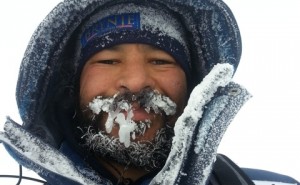 In a bid to prove that bitcoin funds cannot be frozen, Frenchman Faysal Hanneche may soon be the first person to make a digital currency purchase from the South Pole.
In a bid to prove that bitcoin funds cannot be frozen, Frenchman Faysal Hanneche may soon be the first person to make a digital currency purchase from the South Pole.
Danish bitcoin broker Sirius Money is leading the bid to sponsor Hanneche €2,000 to carry a bitcoin sticker on his sledge all the way to the Amundsen-Scott base station in Antarctica, and make the first ever bitcoin purchase from the south pole, purchasing a pizza online via satellite connection just prior to his arrival back in Chile.
Thorkil Værge, head of Sirius Money, has pledged €1,000 (6.8 BTC) to Hanneche, who is undertaking the challenge to travel alone to both poles in a single year. He also says if Hanneche manages to raise more than 15 BTC, he will carry a bitcoin flag with him, if one can be made before his departure from South Africa on November 5th.
If he is successful in his bid to raise enough bitcoins, he will draw attention to bitcoin’s status as the world’s first truly borderless global currency, making a historic transaction in the process.
Hanneche’s colossal round trip of 3500km to the South Pole is the second leg of his journey; he conquered the North Pole in April this year, pulling 120kg of supplies across hundreds of kilometres, in temperatures as cold as -42 degrees Celsius (-44 Fahrenheit). If successful, he will become the first adventurer in history to complete a solo journey to both poles in the same year.
He described the first leg (400km) as being like a chess game: “Two steps forward, one step back”, adding that one morning he found himself 8km back from his objective because the ice had moved so much in the night.
When CoinDesk asked him about why he likes bitcoin, he responded:
“I had money in my bank account in France and needed it to pay for some extra equipment, transport, my flight tickets, etc… but my bank in France limited the money that I could withdraw because I’m abroad and because there are limits on my card here, for example, some people accept MasterCards, others don’t.
I found myself in a very bad situation and it would [have taken] ages to get a money transfer without getting stung by all the fees and the exchange rates. With bitcoin, I was able to fix it all in a few minutes and pay for all the things that I had to pay for in time without losing a lot of money in the process.
Efficient, cost saving and fast is all that I asked for and it was provided. What happened to me in Norway could happen anywhere in the world and so it gives more freedom and flexibility to my finances.”
Just like a careful investor attempting to climb the peaks of ‘Mt.Gox’, Hanneche will often be forced to take detours of several miles to avoid fractures that if fallen through would certainly lead to an icy death in the sea below. He had to go the last 17 miles of his first journey without half of his equipment, risking the possibility of losing his tent and sled on his return, reporting: “I had with me [only] my skis, a satellite phone, food for 24 hours and my flags”.
Having planted his native Valencia’s flag, and a French Tricolor at the north pole, he now expects to do the same at the South, leaving from Cape Town on November 5th and crossing Antarctica to arrive in Chile 80 days later.
Since the trip to is costing a whopping €60,000, he is reaching out to the bitcoin community to raise the equivalent of €2,000, the standard price of sponsorship he charges for a sticker on his sled.
As a historical note the base station at which he will arrive is named after the two explorers who competed to arrive there first in the winter of 1911. Amundsen’s famous strategy of marching 20 miles per day regardless of the weather at the South Pole is often cited as an example of intelligent investment of resources and energy.
Scott, lest we forget, whose strategy by contrast to Amundsen’s was to make best use of the good days and rest on the bad, not only perished himself, but led his team to death in the attempt also.
Since both poles experience only one six-month day of darkness and daylight per year, Hanneche will be unable to navigate by the movement of the sun, noting instead that: “The ice is [constantly] in motion and we adapt to this motion. After two weeks, we move with it. It is the movement of the ice which must be considered”.
There’s no doubting the adventurer’s trip will be tough, so if you want to lend him support, make a donation to his bitcoin wallet address:
1Gt1anYr6gEuiNgacFouhy4RUNQFH3YY9Y
Source and pictures: http://www.coindesk.com/adventurer-make-first-ever-bitcoin-transaction-south-pole/
